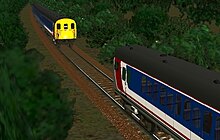This article includes a list of general
references, but it lacks sufficient corresponding
inline citations. (October 2022) |
| Cowden rail crash | |
|---|---|
 | |
| Details | |
| Date | 15 October 1994 |
| Location | Cowden railway station, Kent |
| Country | England |
| Line | Oxted Line |
| Operator | Network SouthCentral |
| Incident type | Single-line collision |
| Cause | SPAD caused by driver error |
| Statistics | |
| Trains | 2 |
| Deaths | 5 |
| Injured | 13 |
| List of UK rail accidents by year | |
The Cowden rail crash occurred on 15 October 1994, near Cowden Station in Kent (UK), when two trains collided head-on, killing five and injuring thirteen, after one of them had passed a signal at danger and entered a single-line section. The cause was driver error, possibly involving a guard who was in the cabin against regulations.
Incident
The 08:00 Up Uckfield- Oxted DMU train, 2E27 consisting of Class 205 three-car units 205018 and 205001 crewed by driver Brian Barton and guard Jonathan Brett-Andrews. Brett-Andrews had ambitions to become a driver and was in the driver's cab at the time of the collision; this was in breach of the operating rules. It is thought that his presence may have contributed to the accident and there were even suspicions that he might have been at the controls; he had been reprimanded three times before for being in the front cab when he should not have. 2E27 departed from Ashurst at about 08:25 and entered a single-track section of line at danger, which ran from Ashurst to Hever station, the signal was meant to be held at danger for 2E27 to await the passage of a Down train.

This Down train was the 08:04 Down Oxted-Uckfield DMU train 2E24, consisting of Class 205 three-car units 205029 and 205032, crewed by driver David Rees and guard R. Boyd. It had just departed Cowden station, already located within the single-line section between Ashurst and Hever, and because of a lack of communication with the train crews, the Oxted signalman was unable to prevent the collision which occurred at around 08:27. In the ensuing collision, the lead car of 2E27 was telescoped by the lead car of 2E24. Both drivers, Barton and Rees, along with guard Brett-Andrews and two passengers, Raymond and Maura Pointer, were killed, the cabs so badly damaged that it was impossible to determine who had been driving 2E27 at the time of impact.
Causes
There were several other contributory factors; it was conjectured that the AWS may have been inoperative (though the official report considers this unlikely), the signal was dirty and the light intensity was low, and there were no trap points to prevent a train wrongly entering a section against the signal. However the official report blamed the driver of the northbound train, Brian Barton.
It was noted that the Oxted signalman, who was aware of the situation, had no direct means of alerting either driver. He attempted to contact the driver of the down train on the signal post telephone, but to no avail (presumably the driver never heard it above the noise of the engine immediately behind him). The signalman did alert the emergency services to the collision while the trains were still one mile apart. The reason for cancelling the contract to fit Cab Secure Radio to this line prior to the incident, as mandated in the wake of the previous Clapham disaster and Hidden report recommendations, remains unclear; however it seems likely that the changes occurring at the time, such as the channel tunnel and privatisation of the rail network, took priority over funding. Radio began to be installed across the railway immediately following the incident, and an inquiry was started.
The accident was exacerbated by the age and design of the multiple units involved. The separate-chassis construction of the elderly British Rail Class 205 stock, based on the BR Mk1 design, led to overriding of one carriage by the next. The weight of the diesel engines above the frames of the coach probably did not help. These trains, unpopular with users of the line because of their age, were replaced in 2004 by Turbostars.
The Wealden Line Campaign, which lobbies for service improvements and extensions to the Uckfield line, had previously predicted in its newsletter Missing Link and via the local press that the line's rationalisation - the reduction to single line sections - could lead to such an event. They continue to campaign for the re-doubling of the route and its development within their BML2 project.
A plaque on the station buildings at Cowden commemorates the accident.
Legacy

- Cab Secure Radio began to be introduced
- SPAD indicators were introduced to protect the entrance to single lines
- AWS magnets were installed at the exits to some maintenance depots to check that a train's automatic warning system is operational. [1]
- Eventually the train protection and warning system was installed at the entrance to single lines and other conflict points.
References
- ^ "Rulebook Master: AWS and TPWS Handbook. Section 1.2 "Depot test magnet: A permanent magnet, used to test the operation of a train's AWS equipment, may be provided at the exit of certain maintenance depots."" (PDF). Network Rail. Archived from the original (PDF) on 10 August 2018. Retrieved 2 November 2017.
Sources
- Hall, Stanley (1999). Hidden Dangers. Ian Allan. ISBN 0-7137-1973-7.
- Holden, C. B. (January 1996). "A report of the Inquiry into the collision between two passenger trains which occurred at Cowden on 15 October 1994" (PDF). Health and Safety Executive. Retrieved 23 January 2011.
- Vaughan, Adrian (2000). Tracks to Disaster. Ian Allan. ISBN 0-7110-2731-5.